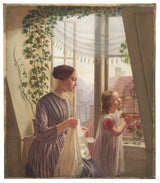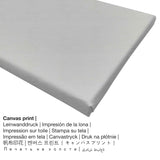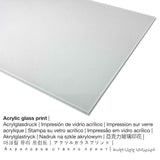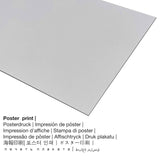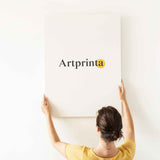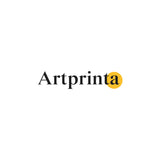Ludvig August Smith, 1853 - Interior with mother and daughter at the window - fine art print
Taxes incluses. Frais de port calculés au paiement.
The painting "Interior with mother and daughter at the window" painted by Ludvig August Smith as your own artprint
The modern art painting was created by the male artist Ludvig August Smith in 1853. The original measures the size: Height: 47,5 cm (18,7 ″); Width: 41 cm (16,1 ″) Framed: Height: 62 cm (24,4 ″); Width: 56 cm (22 ″); Depth: 6,5 cm (2,5 ″). Moveover, this artwork is in the the digital art collection of Nationalmuseum Stockholm, which is Sweden's museum of art and design, a Swedish government authority with a mandatet o preserve cultural heritage and promote art, interest in art and knowledge of art. With courtesy of: Nationalmuseum Stockholm & Wikimedia Commons (public domain license).The creditline of the artpiece is: . The alignment is in portrait format and has a side ratio of 1 : 1.2, which implies that the length is 20% shorter than the width.
Original artwork specifications as provided by the museum (© - Nationalmuseum Stockholm - www.nationalmuseum.se)
English: New Acquisitions, February 2016: Two nudes and an interior by Eckersberg and L.A. Smith Nationalmuseum has acquired a nude by Christoffer Wilhelm Eckersberg (1783–1853) and a second nude and an idyllic interior scene of a mother and child by a window, both painted by Eckersberg’s pupil Ludvig August (L.A.) Smith (1820–1906). Eckersberg is a central figure in the art history of the Danish Golden Age. He was appointed as a professor at the Royal Danish Academy of Fine Arts in Copenhagen in 1818, after studying abroad under Jacques-Louis David and other teachers. In turn, he became the teacher of a whole generation of successful artists during the period known as the Danish Golden Age (c. 1800–50). Eckersberg was a devoted teacher who showed great concern for his pupils, both academically and in a wider sense, even becoming a sort of father figure to some of them. One of the main components of artistic education at the Academy involved drawing and painting from life models. The idea was to familiarize students with the structure and musculature of the human body, so that, as trained artists, they could depict figures in an anatomically correct way when painting detailed historical or biblical scenes. The Academy in Copenhagen did not allow female models to pose nude until 1833; before that, only male models were used. For many years, students painted life models in the evenings, by the light of naked flames, but in 1822 the Academy decided that they would be allowed to paint in natural daylight in future. The two recently acquired nudes, portraying female models, are fine examples of mastery of the effects of daylight. To ensure optimal lighting conditions, Eckersberg moved a painting course focused on female models to the summer months from 1839 onward. Thanks to the painter’s detailed diaries, we know the identities of each summer’s models and students. The model for this Eckersberg painting, seen standing beside a bed and combing her hair, has apparently not been identified previously. On comparison with other works, however, she appears identical to Florentine, who modelled in the summers of 1840 and 1841. The piece is also a fine example of another way in which Eckersberg renewed the genre in Denmark: by portraying the model in an everyday setting, rather than having her pose like a classical sculpture. Smith attended Eckersberg’s summer course for several years. The model for his painting, Cathrine Nielsen, was hired in 1839. The work is a uniquely fine example of how the sharp summer daylight enables the artist to bring out the subtlest effects of the play of light and shadow on skin. The rounded shapes have acquired a markedly sculptural appearance. A painting by Eckersberg of the same model, Cathrine Nielsen, very similar to Smith’s, is now in the Louvre. Nationalmuseum has also been fortunate enough to acquire another work by Smith, an interior scene painted in 1853. This work is an exquisite example of the delicate manner of painting of Danish Golden Age, typifying the intimate, domestic scenes popular at the time. Smith reflects this in his depiction of the room with the street view unfolding beyond the window. Nationalmuseum’s purchase of these works has been made possible by a generous bequest from the Wiros Fund. Nationalmuseum has no budget of its own for new acquisitions, but relies on gifting and financial support from private funds and foundations to enhance its collections of fine art and craft. Inventory Number: Christoffer Wilhelm Eckersberg, Study of a Model. NM 7315 Ludvig August Smith, Woman Plaiting Her Hair, 1839. NM 7317 Ludvig August Smith, Interior with Mother and Child by a Window, 1853. NM 7318 Målningen föreställer en mor och en dotter vid ett fönster i ett biedermeierrum. Utanför fönstret sträcker sig en gata som kantas av äldre bebyggelse. Beskrivning som månadens nyförvärv, februari 2016: Två modellstudier och en interiör av Eckersberg och L. A. Smith Nationalmuseum har förvärvat en aktstudie av Christoffer Wilhelm Eckersberg (1783-1853) samt en modellstudie och en idyllisk interiörscen med mor och barn vid ett fönster utförda av hans elev Ludvig August (L. A.) Smith (1820-1906). Eckersberg räknas som den danska guldålderskonstens portalgestalt och var bland annat elev till Jacques-Louis David. Efter sina utlandsstudier utnämndes han till professor vid Konstakademien i Köpenhamn 1818 där han blev lärare för en hel generation framgångsrika konstnärer under den epok som brukar benämnas den danska guldåldern (ca 1800-1850). Eckersberg var en hängiven lärare som visade stor omsorg om sina elever även utanför studierna. För vissa av dem blev han till och med ett slags fadersgestalt. En av de viktigaste delarna av undervisningen vid Konstakademien bestod i att teckna och måla efter nakenmodell. Det var en del i strävan att lära känna människokroppens muskulatur och uppbyggnad, för att som färdig konstnär kunna skildra den anatomiskt korrekt i avancerade framställningar av till exempel historiska eller bibliska scener. Att låta kvinnor posera nakna blev tillåtet vid Konstakademien i Köpenhamn först år 1833, dessförinnan anlitade man uteslutande män. Länge fick eleverna måla efter modell i artificiell belysning (i belysning från levande lågor) kvällstid men 1822 bestämdes att eleverna skulle få börja måla dagtid i naturligt ljus. De två nyförvärvade aktstudierna visar kvinnliga modeller och är fina exempel på virtuos behärskning av dagsljusets effekter. För att skapa så bra förutsättningar som möjligt förlade Eckersberg från och med år 1839 en särskild kurs med kvinnlig modell till sommarmånaderna. Tack vare målarens noggranna dagboksanteckningar vet man vilka såväl modellerna som eleverna var respektive sommar. Modellen i Eckersbergs studie, kvinnan som kammar sitt hår vid en säng, tycks inte ha identifierats tidigare, men verkar vid jämförelser med andra studier vara identisk med Florentine, som anlitades somrarna 1840 och 1841. Studien är även ett fint exempel på ytterligare en av Eckersbergs förnyelser av genren i Danmark, nämligen att skildra modellen i ett vardagligt sammanhang istället för att som tidigare låta denna posera likt en antik skulptur. Smith deltog i Eckersbergs sommarkurs under flera år. Modellen i hans studie hette Cathrine Nielsen och anlitades år 1839. Studien är ett enastående exempel på hur sommardagsljusets skarpa belysning gör det möjligt för konstnären att få fram även de mest subtila effekterna av ljusets och skuggornas spel över huden. De rundade formerna har givits en påtaglig monumentalitet. Även Eckersberg har gjort en studie av modellen Cathrine Nielsen som är mycket lik Smiths och som idag finns på Louvren. Av Smith har Nationalmuseum även lyckats förvärva ett interiörmotiv från 1853. Målningen är ett känsligt exempel på den danska guldålderns finmåleri och på tidens vurm för intimitet och värderingen av den egna närmiljön. Smith ger uttryck för detta både i rummet och i gatuperspektivet som öppnar sig utanför fönstret. Förvärven har möjliggjorts genom donationsmedel ur Wirosfonden. Nationalmuseum har inga egna medel att förvärva konst och konsthantverk för utan samlingarna berikas genom gåvor och privata stiftelse- och fondmedel. Inventarienummer: Christoffer Wilhelm Eckersberg, Modellstudie. NM 7315 Ludvig August Smith, Kvinna som flätar sitt hår, 1839. NM 7317 Ludvig August Smith, Interiör med mor och dotter vid fönster, 1853. NM 7318
Artpiece table
| Work of art title: | "Interior with mother and daughter at the window" |
| Classification of the artpiece: | painting |
| Art categorization: | modern art |
| Temporal classification: | 19th century |
| Created in the year: | 1853 |
| Artwork age: | around 160 years |
| Original dimensions (artwork): | Height: 47,5 cm (18,7 ″); Width: 41 cm (16,1 ″) Framed: Height: 62 cm (24,4 ″); Width: 56 cm (22 ″); Depth: 6,5 cm (2,5 ″) |
| Museum: | Nationalmuseum Stockholm |
| Museum location: | Stockholm, Stockholm County, Sweden |
| Available at: | www.nationalmuseum.se |
| License: | public domain |
| Courtesy of: | Nationalmuseum Stockholm & Wikimedia Commons |
Background information about the artist
| Artist: | Ludvig August Smith |
| Gender: | male |
| Jobs of the artist: | painter |
| Classification: | modern artist |
Select your product material
We offer a range of different sizes and materials for every product. The following sizes and materials are the options we offer you for individualization:
- The poster print (canvas material): The Artprinta poster print is a UV printed sheet of cotton canvas with a slightly roughened finish on the surface. It is used for framing your art copy with a customized frame. Please keep in mind, that depending on the absolute size of the poster we add a white margin of approximately 2-6cm round about the print motif to facilitate the framing with your custom frame.
- Acrylic glass print: A glossy print on acrylic glass, which is sometimes named as a print on plexiglass, will transform the artwork into amazing wall décor. Moreover, it makes a viable alternative option to canvas and dibond fine art prints. The artwork is custom-made with modern UV direct printing machines. With an acrylic glass art print contrasts and small image details become more exposed thanks to the granular tonal gradation.
- Canvas: The canvas print is a printed canvas stretched on a wood frame. How do I hang a canvas on my wall? The great advantage of canvas prints is that they are relatively low in weight. That means, it is easy to hang the Canvas print without the use of extra wall-mounts. Canvas prints are suitable for any kind of wall.
- Metal print (aluminium dibond): An Aluminium Dibond print is a material with an outstanding depth. For our Direct Print On Aluminum Dibond, we print your selected artwork on the aluminium surface. The colors of the print are luminous and bright, fine details are clear and crisp, and you can perceive a matte appearance of the art print surface.
Structured product information
| Article type: | art copy |
| Method of reproduction: | reproduction in digital format |
| Production method: | digital printing (UV direct print) |
| Provenance: | produced in Germany |
| Type of stock: | on demand |
| Intended usage: | gallery wall, home design |
| Alignment: | portrait format |
| Image aspect ratio: | length to width 1 : 1.2 |
| Implication of image ratio: | the length is 20% shorter than the width |
| Fabric choices: | poster print (canvas paper), canvas print, acrylic glass print (with real glass coating), metal print (aluminium dibond) |
| Canvas on stretcher frame (canvas print) size variants: | 50x60cm - 20x24", 100x120cm - 39x47", 150x180cm - 59x71" |
| Acrylic glass print (with real glass coating) sizes: | 50x60cm - 20x24", 100x120cm - 39x47", 150x180cm - 59x71" |
| Poster print (canvas paper) options: | 50x60cm - 20x24", 100x120cm - 39x47" |
| Aluminium dibond print (aluminium material) size options: | 50x60cm - 20x24", 100x120cm - 39x47" |
| Framing of the art copy: | please bear in mind that this art copy is not framed |
Important legal note: We do all that we can in order to describe the products as closely as possible and to exhibit them visually on the various product detail pages. Nonetheless, the colors of the printing material and the imprint may vary slightly from the representation on the device's monitor. Depending on your screen settings and the condition of the surface, not all color pigments will be printed as exactly as the digital version on this website. Since our are printed and processed manually, there might also be minor deviations in the motif's size and exact position.
Copyright © - www.artprinta.com (Artprinta)

